Everything You Need to Know About Pet Lovebirds
Lovebirds, do in fact, fall in love.
They bond closely with their human companions, forming a loving connection, and are one of a few bird species that mate for life with a birdy BFF. When separated from their loves, they can experience depression.
Although these pint-sized parrots (yes, parrots!) express affection, their common name actually comes from their genus name, Agapornis. "Agap" translates to love, and "pornis" means bird!
We visited with veterinarian Eric Steinberg, DVM, MS, from the Longevity Veterinary Center in New Jersey to learn more about companion lovebirds and how to best care for these feathered friends.
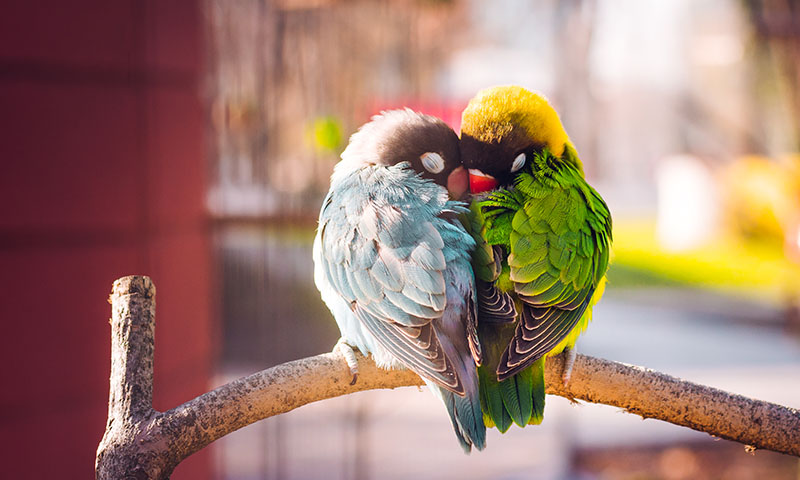
Two lovebirds perched on a branch. Snuggled together, they form a heart!
What Colors Are Lovebirds?
As you browse for the perfect lovebird pet, you'll discover nine colorful species. All originate from Sub-Saharan Africa, with the exception of the Madagascar lovebird, which is sometimes called a grey-headed lovebird.
"The peach-faced lovebird is the most common, popular pet species. Their bodies are usually blue, green, and/or yellow with a distinctive peach-colored face," Steinberg explained.
He says other common species kept as pets include the Fischer's lovebird, which looks like a rainbow with green, orange, brown, and yellow feathers, and black-masked lovebirds sporting a mostly black feathered face. Other species enjoyed by bird enthusiasts include the red-headed lovebird and blue-masked lovebird.
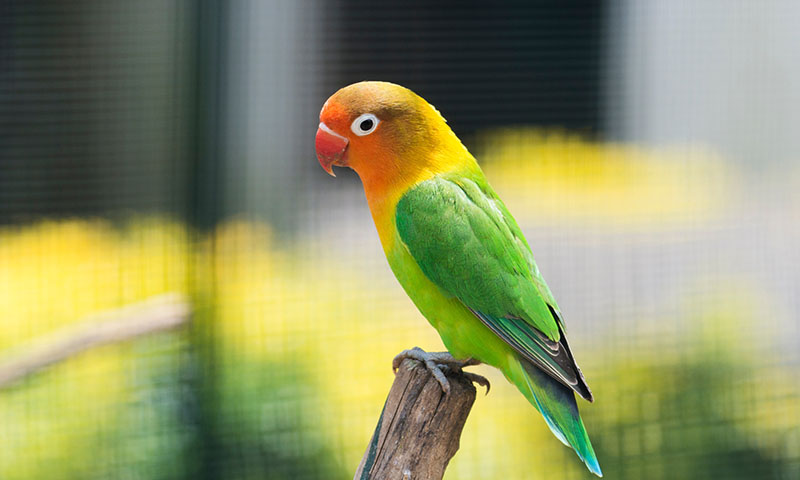
Lovebirds are small parrots that need space to fly.
How Big Are Lovebirds?
Lovebirds measure approximately 4 to 7 inches from head to tail, with size varying by species. They have a wingspan of about 9.5 inches and love to stretch. This means lovebirds need an aviary large enough to handle some short flutters.
Steinberg recommends a habitat measuring 18" x 18" x 18" as a minimum for a single lovebird. If you adopt a pair of birds, which is a good idea for this sociable species, double the aviary size. Choose a style that's longer than taller to facilitate flight. Select an option with bar spacing no wider than 1/2".
Then set up the aviary with food and water bowls, toys, and perches.
"They need plenty of physical and mental stimulation, so they should have no less than three perches of varying sizes and textures," he added.
It's best to place your lovebirds' aviary away from the kitchen, where non-stick pans, air fryers, propane, and appliances that emit odorless, colorless gases are often used. And avoid using things that release smoke, such as incense or candles. Lovebirds have sensitive respiratory tracts. If they breathe in these emissions, they can get sick and die.
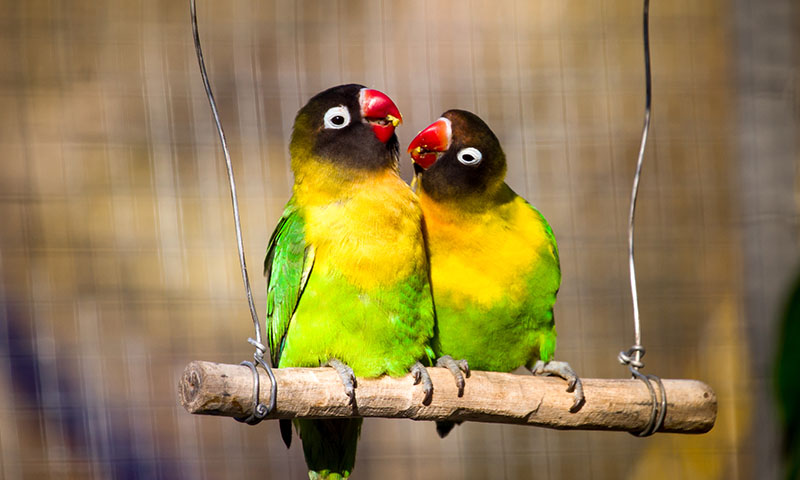
Toys help keep boredom at bay and give you a way to play with your pet lovebird.
Do Lovebirds Like Toys?
Curious, intelligent lovebirds crave time with toys. Steinberg says playtime with toys (and you!) offers mental stimulation and helps prevent boredom.
"They need foraging and shredding toys to keep them active, and to mimic natural behavior, respectively. Lovebirds also need chew toys like calcium or cuttlebone to keep their beaks naturally trimmed and healthy," he explained.
Try offering a shreddable cardboard toilet paper tube filled with a favorite treat that the bird can forage. For example, stuff some Kaytee Bird Greens Treat inside the tube, crimp the ends, and let your lovebird navigate how to get the tube open so she can enjoy the delicious greens.
Feeling crafty? Make one of these parrot toys.
What Sounds Do Lovebirds Make?
Lovebirds most often sing and whistle. Sometimes they will make a clicking sound to gain your attention when they want cuddles, treats, or simply attention in general.
"When you hear them whistling or crooning, it usually means they're happy or enjoying the moment. If you hear them squawking or growling (Yes, they do growl!), it usually means they're not happy," Steinberg shared. "When an owner develops a bond, they'll understand the lovebirds' quirks and nuances to understand what they're trying to communicate."
Unlike macaws or cockatoos, lovebirds do not mimic sounds heard in their environment or speak words.
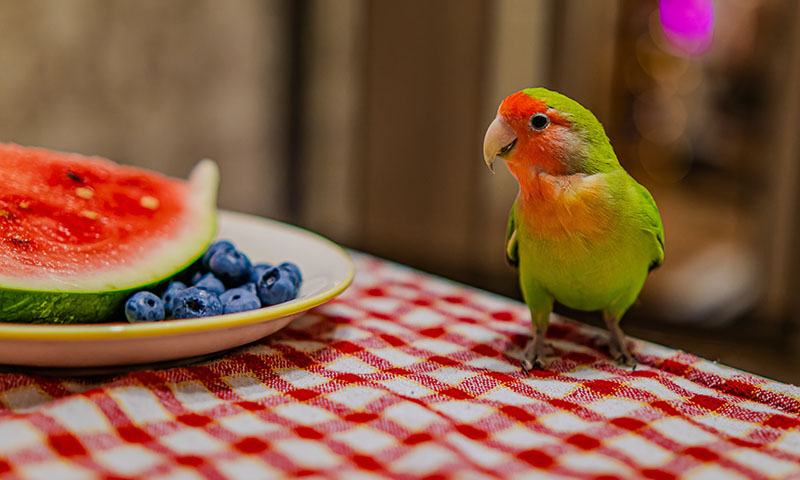
Lovebirds enjoy berries and fruit in addition to a pellet food diet.
What Do I Feed My Lovebirds?
In the wild, lovebirds dine on a mix of berries, grasses, fruits, grains, leaf buds, seeds, maize, and figs. When kept as pets, lovebirds thrive on an equally nutritionally balanced diet that includes greens, vegetables, and fruits.
"Lovebirds should eat a purpose-made food such as the Kaytee Forti-Diet Pro Health, which is an ideal diet for them. While this should comprise the majority of their diet, lovebirds' diet should be enriched with fruits, vegetables, and fresh whole plants," Steinberg shared. "Always remember to remove pits and seeds from fruits, and to avoid foods that have high salt and/or sugar content."
When offering your pet fresh produce, try chopped spinach, green carrot tops, corn on the cob, pea pods, berries, apples, pears, and bananas.
A couple more pet bird food blends to consider feeding your lovebird include:
-
Kaytee Exact Rainbow Parakeet & Lovebird Food: This pellet, or extruded food, offers your lovebird the exact nutrition needed for healthy feathers and bright coloring. Omega 3s support brain and heart health too! You'll love the lack of seed hulls or nut hulls to clean up.
-
Kaytee Forti-Diet Pro Health Egg-Cite Conure & Lovebird Food: If your lovebird is molting (a natural shedding of feathers) or breeding, consider this food mix featuring dried whole egg (which provides extra protein), vitamins, amino acids, and minerals as well as seeds, grains, pellets, nuts, and more!
Lovebirds, just like us, crave snacks. Your pet might enjoy the Kaytee Treat Stick Superfoods Blueberry, packed with dried blueberries, seeds, vegetables, fruits, and more. Or, offer Kaytee Granola Bites with Superfoods Spinach & Kale. Try hand-feeding these during playtime, or add one to the top of your pet's food bowl for a fun surprise!
"Just be mindful when feeding them," Steinberg added. "Common mistakes include over-reliance on a seed-based diet and neglect of fresh foods. Fresh foods should be rotated, and they make great treats when training them."
When you notice fresh fruits and vegetables wilting or browning after a few hours, remove them from the aviary. Then replenish with a new produce treat.
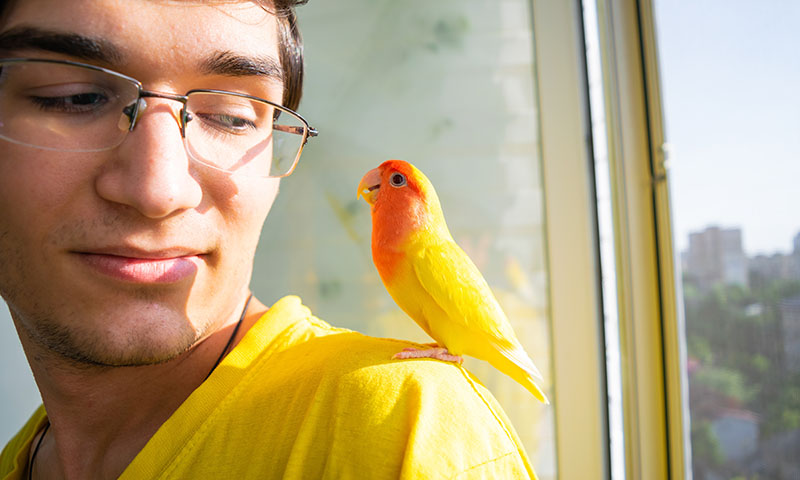
Lovebirds enjoy time bonding with their people.
How Can I Bond With My Lovebirds?
Steinberg says lovebirds are playful, active, and loving, but require patience to create a bond.
"The key is to take it slowly, especially when they first come home to a new environment," he explained. "Also, they need to be in a quiet environment at first, away from stressors such as other pets and children."
It's a good idea to create a daily routine that allows you and your bird to bond over familiar tasks, including refilling fresh water, offering new food, and tidying up the aviary.
In the wild, lovebirds share their food. So Steinberg recommends you do the same with your pet to start forming a close connection. "For example, feed them a small piece of apple and let them see you eating it too," he suggested. Try slicing an apple and offering a wedge to your birdy friend. (Don't share food you've bitten or chewed with your bird. Human saliva contains pathogens that can make pets sick.)
To bond with your lovebird, you can also talk quietly to them or play music and watch their reaction. They may try to mimic a melody for you!
Once you've started to form a connection, and your pet shows interest in touching, Steinberg says to give it a try. Lovebirds enjoy cuddling and getting close to their humans. It's important to offer them some time outside their aviary for their mental wellness and to grow their connection to you.
"Lovebirds in the wild groom each other, so the owner should gently scratch their backs and rub their beaks to establish trust," he added.
How Long Do Pet Lovebirds Live?
A lovebird lives an average of 10 to 15 years, with a 20-year lifespan possible. If you're older, it's a good idea to have a younger family member or friend get to know your bird so it can stay in the family after your passing.
Just like cats and dogs, lovebirds require annual checkups to ensure their wellness.
"They do have issues such as feather plucking and respiratory problems that need to be addressed by a veterinarian immediately when they do arise," Steinberg explained.
.jpg)
Lovebirds are true to their name and make great pets.
Lovebirds Make Endearing Pets
Their beautiful colors and small size will attract you. But it's the affectionate personalities of lovebirds that will make you adore having them as tiny parrot pets.
Spend time each day with your lovebird(s), and your bond will deepen even more over time.
Learn more about caring for a new birdy buddy in How to Convert Your Bird to a New Diet and Pet Birds' Eating Behaviors and How To Identify Them.
